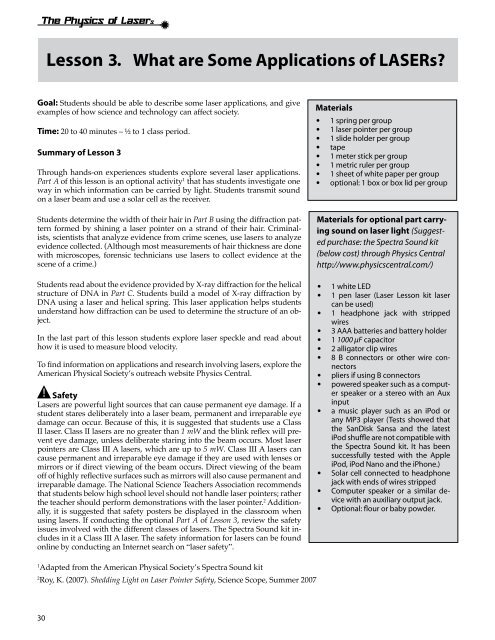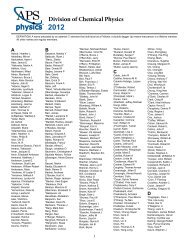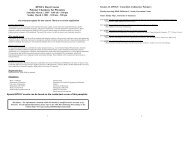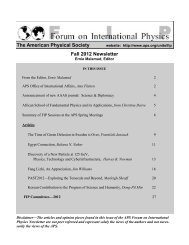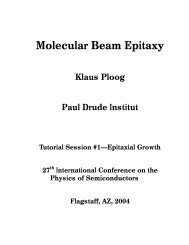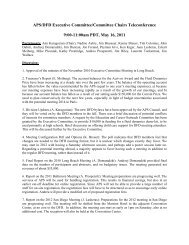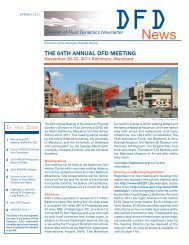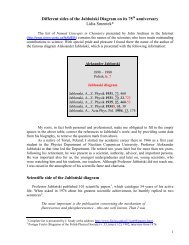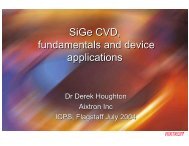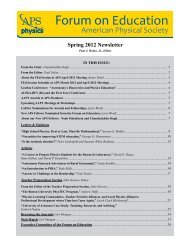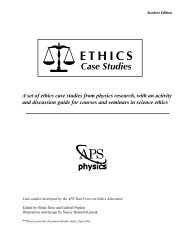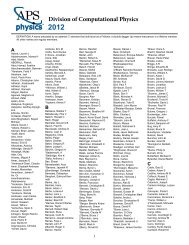The Physics of LASERs - American Physical Society
The Physics of LASERs - American Physical Society
The Physics of LASERs - American Physical Society
You also want an ePaper? Increase the reach of your titles
YUMPU automatically turns print PDFs into web optimized ePapers that Google loves.
30<br />
Lesson 3.<br />
What are Some Applications <strong>of</strong> <strong>LASERs</strong>?<br />
Goal: Students should be able to describe some laser applications, and give<br />
examples <strong>of</strong> how science and technology can affect society.<br />
Time: 20 to 40 minutes – ½ to 1 class period.<br />
Summary <strong>of</strong> Lesson 3<br />
Through hands-on experiences students explore several laser applications.<br />
Part A <strong>of</strong> this lesson is an optional activity 1 that has students investigate one<br />
way in which information can be carried by light. Students transmit sound<br />
on a laser beam and use a solar cell as the receiver.<br />
Students determine the width <strong>of</strong> their hair in Part B using the diffraction pattern<br />
formed by shining a laser pointer on a strand <strong>of</strong> their hair. Criminalists,<br />
scientists that analyze evidence from crime scenes, use lasers to analyze<br />
evidence collected. (Although most measurements <strong>of</strong> hair thickness are done<br />
with microscopes, forensic technicians use lasers to collect evidence at the<br />
scene <strong>of</strong> a crime.)<br />
Students read about the evidence provided by X-ray diffraction for the helical<br />
structure <strong>of</strong> DNA in Part C. Students build a model <strong>of</strong> X-ray diffraction by<br />
DNA using a laser and helical spring. This laser application helps students<br />
understand how diffraction can be used to determine the structure <strong>of</strong> an object.<br />
In the last part <strong>of</strong> this lesson students explore laser speckle and read about<br />
how it is used to measure blood velocity.<br />
To find information on applications and research involving lasers, explore the<br />
<strong>American</strong> <strong>Physical</strong> <strong>Society</strong>’s outreach website <strong>Physics</strong> Central.<br />
!<br />
Safety<br />
Lasers are powerful light sources that can cause permanent eye damage. If a<br />
student stares deliberately into a laser beam, permanent and irreparable eye<br />
damage can occur. Because <strong>of</strong> this, it is suggested that students use a Class<br />
II laser. Class II lasers are no greater than 1 mW and the blink reflex will prevent<br />
eye damage, unless deliberate staring into the beam occurs. Most laser<br />
pointers are Class III A lasers, which are up to 5 mW. Class III A lasers can<br />
cause permanent and irreparable eye damage if they are used with lenses or<br />
mirrors or if direct viewing <strong>of</strong> the beam occurs. Direct viewing <strong>of</strong> the beam<br />
<strong>of</strong>f <strong>of</strong> highly reflective surfaces such as mirrors will also cause permanent and<br />
irreparable damage. <strong>The</strong> National Science Teachers Association recommends<br />
that students below high school level should not handle laser pointers; rather<br />
the teacher should perform demonstrations with the laser pointer. 2 Additionally,<br />
it is suggested that safety posters be displayed in the classroom when<br />
using lasers. If conducting the optional Part A <strong>of</strong> Lesson 3, review the safety<br />
issues involved with the different classes <strong>of</strong> lasers. <strong>The</strong> Spectra Sound kit includes<br />
in it a Class III A laser. <strong>The</strong> safety information for lasers can be found<br />
online by conducting an Internet search on “laser safety”.<br />
1Adapted from the <strong>American</strong> <strong>Physical</strong> <strong>Society</strong>’s Spectra Sound kit<br />
2Roy, K. (2007). Shedding Light on Laser Pointer Safety, Science Scope, Summer 2007<br />
Materials<br />
• 1 spring per group<br />
• 1 laser pointer per group<br />
• 1 slide holder per group<br />
• tape<br />
• 1 meter stick per group<br />
• 1 metric ruler per group<br />
• 1 sheet <strong>of</strong> white paper per group<br />
• optional: 1 box or box lid per group<br />
Materials for optional part carrying<br />
sound on laser light (Suggested<br />
purchase: the Spectra Sound kit<br />
(below cost) through <strong>Physics</strong> Central<br />
http://www.physicscentral.com/)<br />
• 1 white LED<br />
• 1 pen laser (Laser Lesson kit laser<br />
can be used)<br />
• 1 headphone jack with stripped<br />
wires<br />
• 3 AAA batteries and battery holder<br />
• 1 1000 µF capacitor<br />
• 2 alligator clip wires<br />
• 8 B connectors or other wire connectors<br />
• pliers if using B connectors<br />
• powered speaker such as a computer<br />
speaker or a stereo with an Aux<br />
input<br />
• a music player such as an iPod or<br />
any MP3 player (Tests showed that<br />
the SanDisk Sansa and the latest<br />
iPod shuffle are not compatible with<br />
the Spectra Sound kit. It has been<br />
successfully tested with the Apple<br />
iPod, iPod Nano and the iPhone.)<br />
• Solar cell connected to headphone<br />
jack with ends <strong>of</strong> wires stripped<br />
• Computer speaker or a similar device<br />
with an auxiliary output jack.<br />
• Optional: flour or baby powder.


